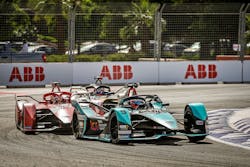So That Happened: Freedom for Pink, Changes at GE and Boost EV Racing Energy Efficiency
Editor’s note: Welcome to So That Happened, our editors’ takes on things going on in the manufacturing world that deserve some extra attention. This will appear regularly in the Member’s Only section of the site.
A Mild Case of Unintended Consequences
Shall we file this under: “Relocating to Texas is no panacea?”
We’re by no means knocking the Lone Star State’s business climate or its proven ability to recruit headquarters and operating facilities from locales—most notably California—viewed as having higher costs and more restrictive regulatory regimes. The state’s lofty status on the ECD front is under no threat.
But we did find ourselves smiling a bit wryly at the panacea thought when we read recently of storied filtration company K&N Engineering Inc. striking a restructuring deal with its lenders after more than six years under the umbrella of Goldman Sachs Asset Management.
The more-than-50-year-old manufacturer has, in the words of Moody’s Investors Service analysts last year, faced “unsustainably high financial leverage, declining demand for its products, and weak liquidity resulting from continually negative free cash flow” which led to it missing debt payments last summer.
A multi-year investment in shifting manufacturing to Texas from California and try to trim its labor costs didn’t pay off; if anything, it backfired by sapping K&N of much-needed cash. Perhaps the lesson to be (re)learned here is that structural problems can’t be addressed by a ZIP code change.
The recapitalization, which is expected to be completed by the end of this quarter, will cut K&N’s debt by about $250 million while the company’s lenders will pump $60 million into the business and let it push forward with some growth plans. The restructuring also comes with a new interim CEO in Randy Bays, who has been overseeing K&N’s operations since last March. Outgoing boss Richard Bisson is stepping aside after three and a half years to run his family office.
Pink Is Free
No, this isn’t about pop stars getting out of jail (to our knowledge, the singer of “U + UR Hand” hasn't been arrested recently). The color pink if free to use.
In December, the U.S. Patent and Trademarks Office Appeals Board ruled that Germany based CeramTec could not consider the color pink a patentable attribute to its ceramic hip replacement devices. Yes, a lawsuit has been fought for more than a decade over the color of a medical device that no one will see after it’s been implanted into patients’ hips.
The core of the dispute was the chemical composition of the ceramic material. It gained its pink coloring from the inclusion of chromia, according to the Patent Office’s ruling. The chromia is a critical functional ingredient, but the coloring it imparts is not, the board ruled.
“We find that the color pink (caused by the addition of chromia) of the compound used to make ceramic hip implant components… is functional based on utilitarian considerations,” the board ruled.
Colorado-based CoorsTek Bioceramics (oh, did I mention that a company founded by beer pioneer Adolph Coors played a role in the fight over pink?) led the challenge to the pink ceramic patents and celebrated its win, saying granting patent protection to cosmetic differences doesn’t serve patients.
“Recent global events have cast a bright light on the dangers of singular or limited supply sources in key markets,” said Jonathan Coors, CEO of CoorsTek. “This decision will not only ensure a consistent supply of crucial components, it will foster competition, drive innovation and enable efficiencies in the surgical marketplace—ultimately benefitting patients receiving critical medical care.”
Energy Efficiency in Auto Racing?!
That’s energy efficiency, not fuel efficiency, mind you. As ABB FIA Formula E, the global racing circuit for F1-style electric cars, enters its ninth season, tech providers and race teams are looking for better data to squeeze more miles per hour out of each kW/h of electricity.
ABB’s Optimax software will collect power use data from the racecars, using 14 metering boxes scattered throughout the race sites, starting in Mexico City in mid-January.
While the application may be motorsports, the target is gaining a better understanding of how vehicles use their electrons to hopefully improve the performances of electric cars in the future.
Daniela Lužanin, head of the ABB Formula E partnership, said, “Energy efficiency is key to reducing emissions and meeting sustainability targets and ABB Ability OPTIMAX will be fully implemented this season to help improve this within the championship.”
And Then There Were Two
Back in November 2021, General Electric announced plans to divide into three businesses focused on healthcare, energy and aviation. The healthcare piece of the puzzle is now a done deal. Last week the manufacturer reported that it has completed the separation of the healthcare business, launching GE Healthcare Technologies Inc. Its Nasdaq ticket symbol is GEHC.
The healthcare-business separation conclusion is in line with the timeline outlined by GE executives in 2021. Also as previously outlined, GE will retain nearly 20% of the shares of GE Healthcare’s common stock.
GE CEO Culp Jr. will serve as non-executive chairman of the new healthcare business.
With regard to the energy and aviation businesses, “We’re on track and confident in our plans to unleash the potential of GE Aerospace and GE Vernova as separate companies in early 2024,” Culp said.
Manufacturing Tech At CES 2023
The annual Consumer Electronics Show (CES) held in Las Vegas, this year from January 5 to January 8, is hit-and-miss for manufacturing-relevant tech. Every year IndustryWeek culls out the technologies shown at CES that might have relevance for the manufacturing industry and this year there were only a few. TCL, known mostly for manufacturing televisions, revealed new augmented reality hardware, the TCL RayNeo X2 glasses. The RayNeo X2 is unique in that each lens has its own screen right in the frame of the glasses for cleaner, sharper visuals. Users can pop corrective lenses into the frames. According to tech journalists that demo'ed the RayNeo X2, the glasses effectively translate languages in real time.
AR/VR/MR technology is used in the manufacturing industry for training and knowledge capture (as discussed in our story on Oshkosh's digital evolution) and it sounds like the RayNeo X2 glasses simplify AR and make it more accessible than ever. They might provide a new entry point for manufacturers that want to pilot the technology.
Exwayz develops 3D mapping software that leverages LiDAR technology (3D navigation technology that bounces lasers off objects to detect their positions relative to the camera) and this year at CES revealed a new generation of software, Exwayz SLAM, that makes it easier to integrate 3D LiDAR mapping into autonomous robots. The software is designed to work with any brand of LiDAR system and for a wide variety of autonomous robot deployments.
Autonomous mobile robots (AMRs) see use in manufacturing to shuttle raw materials from warehouses to factory floors, or from material storage towers to machines on the line, or even in-between stations on the floor as products move from production stage to production stage. So any new 3D navigation system that might make AMR navigation more robust could also make the technology easier for manufacturers to deply in a wider variety of situations.
If Exwayz SLAM makes it possible to more easily repurpose AMRs on the fly, like adapting to changes in floor layouts, that could make the technology more affordable and attractive for manufacturers to integrate.
Finally, and this kind of a stretch, John Deere revealed a new electric excavator that uses a Kreisel battery. These batteries purportedly have longer lifetimes, better safety and superior performance compared to other types of EV batteries, so John Deere's electric excavator might help popularize this new battery tech. That, in turn, could have effects on the EV vehicle industry at a time when companies like GE Appliances are integrating EVs into factory operations.
CES also had things like a child stroller with AI-aided navigation, video game controllers designed for players with limited motor control, fingertip blood pressure monitors, and of course new laptops and television sets, but you'll have to read about those elsewhere.
About the Author
Geert De Lombaerde
Senior Editor
A native of Belgium, Geert De Lombaerde has been in business journalism since the mid-1990s and writes about public companies, markets and economic trends for Endeavor Business Media publications, focusing on IndustryWeek, FleetOwner, Oil & Gas Journal, T&D World and Healthcare Innovation. He also curates the twice-monthly Market Moves Strategy newsletter that showcases Endeavor stories on strategy, leadership and investment and contributes to other Market Moves newsletters.
With a degree in journalism from the University of Missouri, he began his reporting career at the Business Courier in Cincinnati in 1997, initially covering retail and the courts before shifting to banking, insurance and investing. He later was managing editor and editor of the Nashville Business Journal before being named editor of the Nashville Post in early 2008. He led a team that helped grow the Post's online traffic more than fivefold before joining Endeavor in September 2021.
Robert Schoenberger
Editor-in-Chief
LinkedIn: linkedin.com/in/robert-schoenberger-4326b810
Bio: Robert Schoenberger has been writing about manufacturing technology in one form or another since the late 1990s. He began his career in newspapers in South Texas and has worked for The Clarion-Ledger in Jackson, Mississippi; The Courier-Journal in Louisville, Kentucky; and The Plain Dealer in Cleveland where he spent more than six years as the automotive reporter. In 2014, he launched Today's Motor Vehicles (now EV Manufacturing & Design), a magazine focusing on design and manufacturing topics within the automotive and commercial truck worlds. He joined IndustryWeek in late 2021.
Chris McNamara
Editor-in-Chief: Smart Industry
Publication: Smart Industry is owned by IndustryWeek parent company Endeavor Business Media.
Quote: “Working in this digital transformation space for the past decade has been like catching a tiger by the tail…each day delivers massive changes, huge opportunities and the emergence of tools, trends and technologies that are—to put it simply—improving the ways we work and live.”
- Smart Industry editor in chief since 2019
- Connectiv Editorial Council Member
- Freelance magazine journalist covering topics from digital transformation to travel
Jill Jusko
Bio: Jill Jusko is executive editor for IndustryWeek. She has been writing about manufacturing operations leadership for more than 20 years. Her coverage spotlights companies that are in pursuit of world-class results in quality, productivity, cost and other benchmarks by implementing the latest continuous improvement and lean/Six-Sigma strategies. Jill also coordinates IndustryWeek’s Best Plants Awards Program, which annually salutes the leading manufacturing facilities in North America.
Have a story idea? Send it to [email protected].
Dennis Scimeca
Dennis Scimeca is a veteran technology journalist with particular experience in vision system technology, machine learning/artificial intelligence, and augmented/mixed/virtual reality (XR), with bylines in consumer, developer, and B2B outlets.
At IndustryWeek, he covers the competitive advantages gained by manufacturers that deploy proven technologies. If you would like to share your story with IndustryWeek, please contact Dennis at [email protected].




